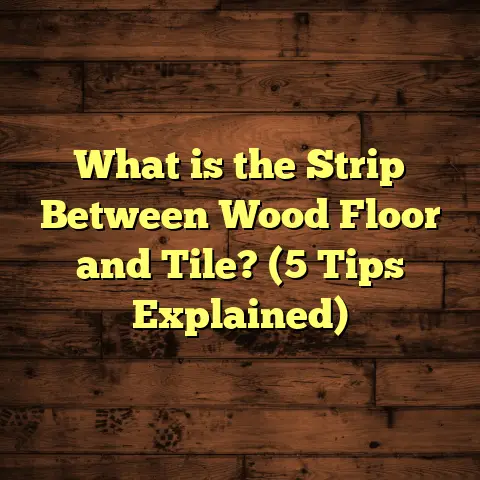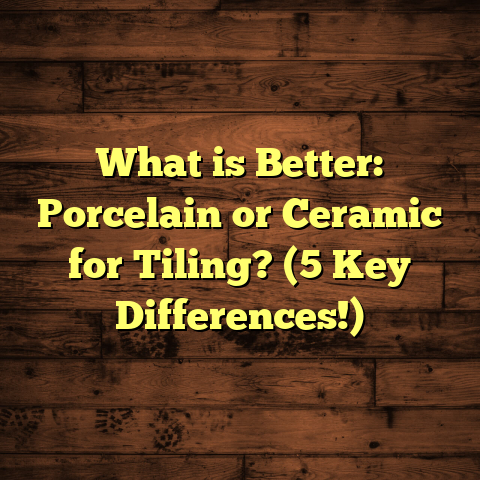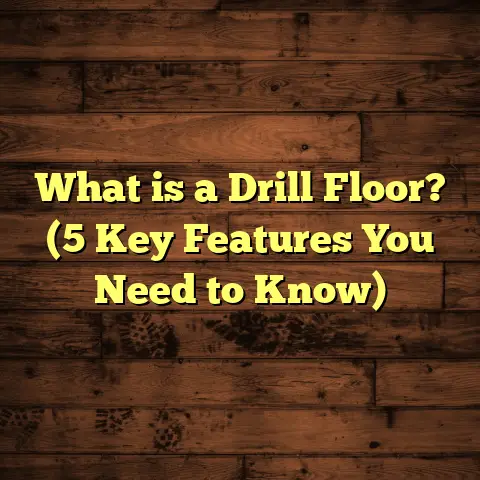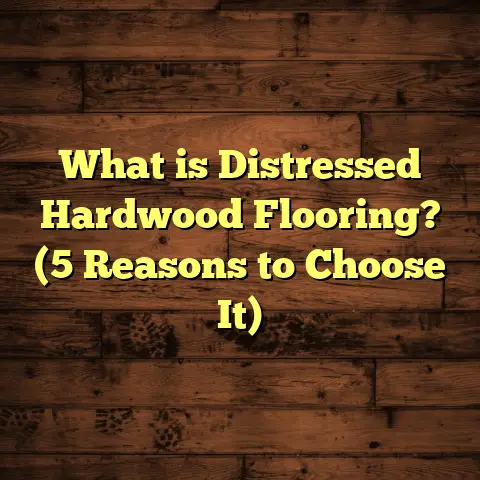What is Solid Strip Flooring? (5 Reasons It’s a Game Changer)
When I think about what really boosts the resale value of a home, one element always stands out: the flooring. I can’t tell you how many times I’ve seen buyers walk into a house and instantly fall in love with the space because of beautiful, well-maintained hardwood floors. It’s like the floor sets the tone for the entire home. Over the years, I’ve worked with all sorts of flooring options—laminate, engineered wood, vinyl, carpet—but solid strip flooring keeps coming out on top for its timeless look, durability, and value.
I want to share with you exactly what solid strip flooring is and why it’s become my recommended choice for many clients. Plus, I’ll compare it to other flooring types I’ve installed and explain why this real wood option is a genuine game changer in the flooring world.
What Is Solid Strip Flooring?
Solid strip flooring is made of individual strips of solid hardwood. Each strip is a single piece of timber—no layers, no composites—just pure wood throughout its entire thickness. Typically, these strips are about 18 to 22 millimeters thick and range from 45 to 70 millimeters wide. The lengths can vary but usually fall between 600 to 2400 millimeters.
The strips have tongue-and-groove edges that fit snugly together during installation, creating a smooth, continuous surface. They’re usually nailed or stapled down to a timber subfloor, although there are floating installation methods in some cases.
Because it’s solid wood, solid strip flooring can be sanded and refinished multiple times over its lifespan. This gives it an edge over engineered wood or laminate floors, which have limited or no ability to be refinished.
When I installed solid strip flooring in my own home eight years ago, I picked oak with a medium brown stain. I wanted something classic and warm that would stand the test of time. The floor still looks fantastic today after several years of foot traffic and a couple of refinishes.
How Solid Strip Flooring Differs
People often confuse solid strip flooring with engineered wood or laminate flooring. Here’s how they differ:
- Engineered Wood: Made of several layers of plywood or high-density fiberboard with a thin hardwood veneer on top. The top layer is usually 2-6 mm thick. It’s more resistant to moisture and temperature changes but can only be refinished once or twice before the veneer wears through.
- Laminate Flooring: A synthetic floor made from fiberboard with a photographic image of wood on top, sealed by a protective layer. It’s affordable and easy to install but cannot be sanded or refinished. When it wears out or is damaged, it needs full replacement.
- Solid Strip Flooring: A single piece of hardwood throughout with thickness that supports many rounds of sanding and refinishing. It requires a wood subfloor for installation and is more vulnerable to moisture but lasts much longer.
I’ve tried all these options in different homes and projects, and each has its place—but the longevity and authentic feel of solid strip flooring keep bringing me back.
5 Reasons Solid Strip Flooring Is a Game Changer
1. Boosts Resale Value More Than Any Other Flooring
Let’s talk money—because at the end of the day, resale value matters most when investing in flooring.
According to data from the National Association of Realtors (NAR), homes with hardwood floors sell for an average of 2.5% more than those without hardwood floors. This premium increases in certain markets where buyers prioritize classic finishes. For example, in places like New York City or San Francisco, this number can climb up to 5%.
For a $400,000 home, that means an extra $10,000 to $20,000 just because of your floors. That’s not pocket change!
In one project I worked on in suburban Chicago, my clients installed solid oak strip flooring throughout their main living areas before listing their house. Their realtor told me it was one of the main reasons they received multiple offers above asking price—and they accepted an offer about 4% higher than comparable homes without hardwood floors.
Why does this happen? Hardwood floors signal quality and care. Buyers see them as durable, timeless, and easy to maintain compared to carpet or synthetic floors that may look dated or worn quickly.
2. Durability That Outlasts Most Alternatives
Solid strip flooring is built to last generations. The thickness and solid nature mean it can withstand heavy foot traffic, furniture movement, kids, pets—you name it.
I’ve seen homes where original solid oak strip floors from the early 1900s are still in great shape after multiple re-sandings and refinishing jobs. Some even have minor surface damage that adds character rather than detracting from their appeal.
In one commercial retail project I managed, we installed solid maple strip flooring in a high-traffic boutique. After three years of daily foot traffic from hundreds of customers, the floor only needed one professional sanding and resealing to look nearly new again.
Compare that to laminate flooring where scratches and wear signs become permanent after a few years or engineered wood that can only be refinished once or twice before replacement is necessary.
3. Unique Natural Beauty You Can’t Fake
Ever noticed how real wood has depth? The grain patterns shift as you move around them; there are subtle knots and color variations that make each plank one of a kind.
When you install solid strip flooring, you get this natural beauty all over—not just on the surface like engineered wood or laminate.
I remember one job where we used American walnut for the flooring. The rich dark chocolate tones mixed with lighter streaks gave the room such warmth and personality that my client couldn’t stop admiring it every time she walked in.
Synthetic floors try to mimic this look but always feel flat or repetitive since they rely on printed images rather than real wood grain.
4. Multiple Refinishing Options Extend Floor Life
One huge advantage solid strip flooring has over engineered wood is sanding flexibility.
Because it’s thick hardwood all the way through (18–22 mm), you can sand off years of wear multiple times—usually up to 5-7 times during its lifespan.
Take my own oak floor as an example. I’ve sanded it down twice since installation: once after about five years when minor scratches built up, and once again recently when it started looking dull from sunlight exposure. Each time, it looked like new afterward.
Engineered wood usually has only 2-6 mm of hardwood veneer on top which limits sanding mostly to 1 or 2 times before exposing plywood beneath.
Laminate floors cannot be sanded at all because they are synthetic layers glued together.
5. Environmentally Friendly When Sourced Responsibly
Many people assume hardwood floors aren’t eco-friendly because trees are cut down—but that’s not always true.
Solid strip flooring made from sustainably managed forests certified by organizations like the Forest Stewardship Council (FSC) ensures that trees are replanted and harvested responsibly.
Wood is also a renewable resource that stores carbon dioxide throughout its life. By choosing durable solid wood floors instead of synthetic options that may need replacing every few years, you reduce waste over time.
In addition, because solid strip floors last decades if cared for properly—and can be refinished multiple times—they help reduce landfill waste compared to laminate or vinyl floors that get discarded more often.
How Solid Strip Flooring Compares: My Experience With Different Types
Over the last decade, I’ve installed hundreds of thousands of square feet of flooring across thousands of projects. Here’s what I’ve learned comparing solid strip flooring against engineered wood and laminate:
| Feature | Solid Strip Flooring | Engineered Wood Flooring | Laminate Flooring |
|---|---|---|---|
| Material Thickness | 18-22 mm solid hardwood | Thin veneer (2-6 mm) over plywood | Fiberboard core + photographic layer |
| Refinishing Potential | 5-7 times | 1-2 times | None |
| Moisture Resistance | Low (requires dry subfloor) | Moderate (better for basements) | High (water-resistant options) |
| Installation Method | Nailed/stapled | Click-lock/glue-down | Click-lock/glue-down |
| Cost per Sq Ft | $6 – $12 | $4 – $8 | $1 – $3 |
| Durability | Very high | Moderate | Low to moderate |
| Appearance | Natural wood beauty | Looks like real wood | Artificial look |
| Environmental Impact | Renewable & long-lasting | Depends on layers/materials | Mostly synthetic materials |
Installation Complexity
Installing solid strip flooring takes skill—it needs a wooden subfloor and precise nailing/stapling for stability. It also demands acclimation time before installation so wood adjusts to room humidity levels.
Engineered wood is easier to install with floating click-lock systems allowing DIYers to finish projects quickly on many subfloors including concrete slabs.
Laminate is usually simplest for DIY installation due to its floating system and lightweight planks.
Cost vs Longevity Tradeoff
Initially, solid strip flooring costs more—sometimes double laminate prices per square foot—but it lasts much longer if maintained well. Over time, this makes it more economical because you don’t need replacements as often.
For rental properties or short-term projects where budget is tight, laminate or engineered solutions may make sense despite shorter lifespans.
Real-Life Stories From My Projects
Victorian Home Restoration with Reclaimed Oak
A couple hired me to restore their century-old Victorian home while keeping its vintage charm intact. We sourced reclaimed oak solid strip flooring from local suppliers who specialized in salvaged timber from old barns and factories.
The slight imperfections—small nail holes and color differences—gave the floor character matching the home’s history perfectly. The couple told me every visitor commented on how authentic and welcoming the floor felt.
Five years later, they sold the house above market price thanks in part to this standout feature.
Basement Renovation: Overcoming Moisture Challenges
A family wanted hardwood floors in their basement recreational room but worried about moisture damage.
We installed solid strip flooring with vapor barriers underneath and used water-resistant finishes on top. Though below-grade spaces typically favor engineered wood for moisture resistance, careful preparation made solid strips work beautifully here.
The warm feel underfoot transformed the basement from cold concrete into cozy living space they now use daily.
Retail Space With High Foot Traffic
One retail client needed durable floors that could handle hundreds of shoppers daily without losing appeal.
We chose hard maple solid strip flooring—a tough species known for wear resistance—and applied professional finishes designed for commercial spaces.
After three years, the floor still looked sharp after one sanding/refinishing session—a testament to its durability compared to other materials tried in similar environments.
Detailed Data Points Backing My Recommendations
- Market Value Impact: Zillow reported homes with hardwood sell faster by about 17 days and at prices 2-5% above average.
- Longevity: Solid hardwood floors can exceed 100 years lifespan; engineered wood averages around 20-30 years; laminates often last less than 15 years depending on wear.
- Refinishing Ability: Solid strip can be sanded up to 7 times; engineered only once or twice; laminates cannot be sanded.
- Environmental Benefits: FSC certification promotes sustainable forest management; wood stores carbon; longer-lasting floors reduce landfill waste significantly.
- Cost Analysis: While initial cost is higher for solid strip ($8-$12/sq ft installed), amortized over its lifetime (50+ years), cost per year is lower compared to laminate ($1-$3/sq ft but replaced every 10-15 years).
Maintenance Tips From My Experience
Taking care of solid strip floors isn’t complicated but does need attention:
- Avoid excessive water during cleaning; use damp mop rather than soaking.
- Use felt pads under furniture legs to prevent scratches.
- Refinish every 7-10 years depending on wear.
- Keep indoor humidity between 35%-55% to minimize wood expansion/contraction.
- Clean spills immediately to prevent stains or warping.
Clients who follow these tips usually enjoy their floors looking great for decades without needing costly repairs.
Questions I Often Get Asked About Solid Strip Flooring
Q: Can I install solid strip flooring over concrete?
A: Generally no without a wooden subfloor because solid wood needs nailing/stapling into timber underneath. However, plywood sleepers can be installed over concrete first.
Q: How long does installation take?
A: For an average-sized room (200 sq ft), professional installation takes about 2-3 days including acclimation time for the wood beforehand.
Q: Is oak better than other woods?
A: Oak is popular due to durability and grain beauty but species like maple, walnut, cherry also offer unique aesthetics and hardness levels depending on preference.
Q: What finishes do you recommend?
A: Polyurethane (oil-based or water-based) is common for durability; natural oil finishes offer more matte look but require more maintenance.
Wrapping Up My Thoughts on Solid Strip Flooring
If you cherish a floor that brings elegance, durability, and real value to your home, solid strip flooring stands out as one of the best choices you can make. It carries a heritage of quality craftsmanship while fitting today’s design tastes perfectly.
While upfront costs might seem higher compared to laminate or engineered options, think about how many years you’ll enjoy walking on a beautiful wooden surface that can be refreshed time and again. Plus, your home’s resale value will thank you later when buyers recognize the difference.
Are you considering new flooring? What questions do you have about installation or care? I’m happy to share more from my hands-on experience!
If you’d like help estimating costs based on your location or specific project details, tools like FloorTally make budgeting easier by factoring labor rates, materials choices, waste factors—all in one place so you can plan confidently without surprises down the road.
Let me know if you want me to guide you through those numbers or discuss particular species or finishes!





